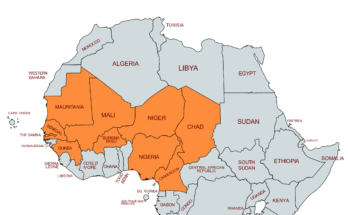
After a week of sustained protest actions and violence in the wake of a disputed election cycle, Bolivian President Evo Morales announced his resignation from the presidency under pressure from the country’s armed forces, which had announced their intention to intervene in the emerging crisis.
Elected in 2006, Morales was the country’s first indigenous president and a prominent member of the “pink tide” of left-leaning leaders who rose to authority across the region in the mid-2000s. After over a decade in office, Morales’ dramatic fall opens an uncertain new era in Bolivia’s political landscape. Longstanding class and ethnic divides have again burst into the open. The immediate aftermath of the crisis has raised the prospect of a return to the country’s authoritarian past.
The Pink Decade
Morales first rose to national political prominence as the leader of the country’s trade union for coca farmers. His ascension took place during the tumultuous period of national politics that immediately followed the country’s transition from decades of authoritarian military rule to electoral democracy in 1983. For peasant and indigenous farmers in rural Bolivia, the cultivation of coca had long been an agricultural mainstay. However, in an era in which the regional narcotics trade was undergoing significant growth, the crop came under increasing scrutiny from government authorities because of its potential to be exported and processed further into cocaine.
The presiding governmental authorities of the era sought to eradicate coca cultivation through a range of new policies involving both compensation and – more commonly – coercion. Morales’ union post placed him in opposition to these policies. This fraught period witnessed increasingly frequent and lethal confrontations between state security and law enforcement bodies and rural communities in a struggle of local norms against centralized authority. Morales’ union activism translated into the formation of an emergent political infrastructure and constituency among rural and indigenous Bolivians.
During the early 2000s, Morales entered the national spotlight once again. This time, he drew attention as a prominent leader during the protests and political struggles that arose in response to the privatization of water and gas services in Bolivia. Ultimately, this upheaval would result in the resignations of sitting President Gonzalo Sanchez and his vice president Carlos Mesa. The events further established Morales’ domestic and regional reputation as a fierce critic of international lending organizations such as World Bank and International Monetary Fund (IMF) and a persuasive political organizer outside of the existing political structures.
Snap elections followed the end of the political crisis in 2005, and Morales ran for president under the banner of the Movement for Socialism – Political Instrument for the Sovereignty of the Peoples (MAS-IPSP) party. Morales ran on a populist left-wing political platform that promised improvements to Bolivia’s standard of living (which would be funded through the nationalization of lucrative domestic industries) and the expansion of indigenous rights and legal protections. He won with just over 50 percent of the vote.
In the decade plus that followed this initial victory, Morales and the MAS-IPSP instituted a wide range of major structural reforms to the Bolivian state. The country was refashioned as the “Pluranational State of Bolivia” in acknowledgment of its multiethnic demography. Oil and gas reserves were nationalized, and the attendant new funds were directed into public programs and the stabilization of the country’s balance of payments.
Although the favorable conditions of the commodities market significantly buoyed Morales’ ability to implement these policies without incurring an excessive debt burden, the administration also pursued predominantly sound, rational fiscal policies throughout its tenue and invested in the long-term development of the country’s economic and infrastructural base. This sober approach to governance would insulate Bolivia from some of the most adverse effects of the regional economic downturn of the 2010s and largely avert the crippling financial problems that would come to hound many other Latin American governments.
Morales won landslide victories in the general elections of 2009 and 2014, attaining over 60 percent of the vote in both cases. Bolivian voters awarded the MAS-IPSP a continuous and nearly uncontested period of 13 years in power, and with it a broad mandate to pursue its legislative agenda and refashion national politics. The tangible achievements of the government’s policy program were substantial. After years of turmoil and decline, Bolivia would witness sustained growth to its GDP over the coming years, often in excess of 4 percent annually, and the country’s extreme poverty rate would drop from 38% in 2006 to 17% by 2018.
According to Bolivia’s 2009 Constitution, the president is elected for five-year terms, with limitations restricting candidates to two consecutive terms. Through a constitutional court ruling and subsequent passage of legislation in 2013, the limit was amended to three consecutive terms. The 2013 ruling allowed Morales to run for a third presidential term. In 2016, Morales and the MAS-IPSP initiated a new legislative package – with its passage to be determined via national referendum – to amend the constitution again in order to allow him to run for a fourth consecutive term. The referendum resulted in a narrow defeat for Morales; 51 percent of Bolivians voted against the constitutional change.
The low turnout for Morales indicated the waning cohesion and enthusiasm of the President’s previously unwavering electoral coalition. Bolivia’s economy remained relatively strong, and the MAP’s economic policies were still popular, but Morales’ reputation among the public as the central figurehead of the government had become more complicated than it had been in years past.
The industrial development policies that provided the Bolivian state with growing wealth and were popular with some rural constituencies and the country’s burgeoning middle class generated dissatisfaction from indigenous populations, who questioned the ecological impact of the policies and the transparency with which major industrial contracts were arranged. A number of other development issues also strained Morales’ relationship with core constituencies such as agricultural workers and miners.
In 2016, a much-publicized corruption scandal involving Morales’ former girlfriend and a Chinese mining firm combined with Morales’ decision to seek a fourth term generated additional domestic debate as to the propriety of his increasingly long stay in power.
These scandals mobilized Bolivia’s once-divided and electorally marginalized centrist and conservative opposition. The opposition began to operate with a greater level of street cohesion, and it soon coalesced around a core subset of charismatic new political leaders and assertive mobilization strategies. This cohesion enabled the opposition to execute larger and better-organized protest actions during the clashes surrounding the constitutional court ruling and other controversial political episodes.
These events elevated the status of several political figures. One of the most critical of these was Luis Fernando Camacho, who became a major protest leader in the aftermath of the 2019 election. A lawyer by trade, Camacho first entered the political scene in the early 2000s, holding leadership posts in regional committees representing elements of the local middle-class business community and its interests in the westernmost region of Santa Cruz.
Early in his political career, Camacho held a leadership post in the Cruceñista Youth Union, a far-right-wing youth organization with ideological origins in the country’s 20th century conservative and Falangist movements. Later, observers under the United Nations censured the organization for its attacks on indigenous merchants during the early years of Morales’ presidency.
Eventually, Camacho rose through the ranks of various other regional civic organizations oriented around local business concerns – all staunchly opposed to the Morales government. In early 2019, Camacho attainted the position of President of the Civic Committee of Santa Cruz and quickly became the face of the more radical sectors of the opposition.
In 2017, Bolivia’s Constitutional Tribunal overturned the results of the 2016 referendum that had reaffirmed the three-term limit for presidents. The ruling contended that the imposition of term limits – on any political office in the country, including the presidency – would violate the political rights of the office holders under the terms of the 1969 American Convention on Human Rights. Thereby, Morales was cleared to pursue a fourth presidential term.
Domestic and international critics argued that the court’s ruling indicated the judiciary was fettered to the interests of the sitting MAS government. Although the judges of the Bolivian constitutional court are elected through an ostensibly nonpartisan process, a candidate’s eligibility for placement on the ballot is first vetted through the national legislature and thus subject in some measure to the preferences of the party or parties in power.
In the lead-up to the 2019 elections, the Morales administration invited observers of the Organization of American States (OAS) to audit the election process and voting results. The OAS is a multilateral organization consisting of 35 member states spanning North and South America, including major regional states such as Brazil. The institution focuses the majority of its contemporary initiatives on providing monitoring and oversight of democratic elections, channels for reginal conflict arbitration, and a cooperative framework for work on regional development and security issues.
The OAS has long stood at the center of an often-volatile public debate across Latin America –one that extends into Bolivian politics. Months prior to the election, former president under the conservative Christian Democratic Party Jorge Quiroga made unsourced allegations that the OAS and President Morales were colluding to ensure Morales’ re-election. Quiroga made these allegations in response to statements from the OAS’ sitting chairman that expressed support for Morales’ legal right to run for a fourth term. By contrast, critics from other quarters contend that the Cold War era organization exists largely to serve the interests of powerful regional states, such as the U.S, over those of the majority of its ideologically diverse membership.
Despite its contested reputation, the stature of the OAS as an impartial outside observer and credible source of electoral legitimation makes its approval much sought after across the region. Its authority in this domain would become highly salient in the coming political crisis.
The Election Crisis
The 2019 Bolivian General elections were held on October 20. Morales’ primary electoral challenger was former President Carlos Mesa, representing the centrist Civic Community party. A coalition of parties opposed to another Morales term created the Civic Community party in 2018.
The proximate origin of the country’s political crisis lay in the disputed narratives surrounding the chronology of events that occurred on the day of the election and the subsequent report on electoral interference released by the OAS. Throughout the early stages of the day’s voting, returns indicated that neither party would achieve a victory sufficient to avoid a second runoff phase.
Late into the day, however, the Bolivian government’s election monitor ceased counting further votes under the provisional “quick-vote” counting system and moved to begin conducting the final official vote count. As the election ended, late electoral returns for Morales surged, placing him above the threshold for requiring a runoff. Instead, he achieved a first-round victory.
Opposition activists and a range of other non-electoral figures – representing a wide range of cross-ideological regional and social organizations – responded to the sudden upsurge in votes for Morales with claims that fraudulent actions on the part of the sitting authorities had compromised the integrity of the elections. Around the same time, OAS released a provisional statement indicating that the late-day upsurge in votes and cessation of vote counting under the “quick-vote system” was representative of probable signs of interference.
Carlos Mesa and other opposition leaders called for their supporters launch protests in response to the events. Throughout the coming days – as the final vote counts were tallied and the OAS conducted its final audit under government request – protest actions erupted in urban centers across the country, involving peaceful actions and strategic blockades of major transit arteries. Events escalated into violent clashes between supporters of the opposition and the MAS and between various protest parties and Bolivian police. A policeman and multiple protesters lost their lives. Radical elements of the protest movement burned down a number of government facilities and private homes and committed physical battery against local officials aligned with the MAS.
On October 25, the Bolivian election authorities announced that all votes had been collected. Morales had emerged victorious with 47 percent of the vote, compared to the 36 percent secured by Mesa. Prominent opposition members such as Mesa and Camacho reiterated their rejection not only of the election results but also of the coming OAS audit. Soon, they made the first public calls demanding Morales’ unconditional resignation and the police and military’s defection to the side of the opposition.
On November 10, the OAS released the provisional results of its audit of the election. The audit found a series of irregularities in voting procedures and determined that Bolivian election officials did not abide by best practices. Although initially defiant in his party’s victory, the results of the OAS audit and continued protest action prompted Morales to call for a fresh set of elections to be held. The elections were to be in concert with a new OAS audit and with structural overhauls made to Bolivia’s election authorities.
Competing explanations of the controversial events of the election posit that Morales’ late-day surge was a result of simple geography: the votes of his primarily rural constituencies took longer to arrive than those of the middle-class urban voting blocs. This alternative explanation also argues that the period of transition between the quick and final voting systems was a somewhat mismanaged but otherwise routine procedure. However, with the country having entered a new stage of the tumult, it is unlikely that greater clarity will soon emerge regarding the election.
In any case, conditions on the street and in the corridors of critical Bolivian security institutions accelerated the fracture of the political landscape beyond the point of possible reconciliation. On November 9 and 10, Bolivian police forces defected to the opposition en masse and called for Morales’ resignation. Morales then lost the support of critical institutional ally, the Bolivian Workers Center, the country’s primary trade-union federation, which called for Morales to step down from the presidency in order to avert further violence.
With Morales’ supporters appearing disorganized or disillusioned and the opposition ascendant, the Bolivian Military leadership executed its decisive move. Commander in Chief Williams Kaliman Romero effectively removed Morales from power in a speech wherein he suggested the president’s resignation. This was done with the implicit backing of the armed forces as an institution. Morales promptly resigned his office, stating he had done so to prevent further violence but decrying the events as a coup. Subsequently, Morales fled the country into asylum in Mexico under the administration of left-leaning President Andrés Manuel López Obrador.
The Opposition in Power
On November 12, opposition lawmaker and Senate Vice President Jeanine Áñez was declared interim president of the country. The Bolivian legislature approved Áñez’s decision. However, the majority of the MAS party boycotted the vote or were barred from entering the chamber by police forces. The country’s Constitutional Tribunal approved of the decision.
The political landscape in Bolivia now exists in a highly fluid condition. Supporters and opponents of Morales are taking stock of their position and reorganizing their alliances and missions in light of the vacuum left by the lack of a centralized authority. A nascent interim government comprised of opposition figures now resides over a fragmented legislative environment. This unsteady government is responsible for navigating the country through the interregnum period before the launch of new general elections.
In the aftermath of the declaration of her acting presidency, Áñez released a statement promising to be a president for all Bolivians and vowed to hold new elections within 90 days. However, in the days following the establishment of the interim government, Áñez and her political allies have appeared to move forcefully to consolidate opposition control over the bureaucratic apparatus, reorient state policy, and pursue a crackdown on counter-protests conducted by supporters of Morales and the MAS.
Not long into their time in office, Áñez and several members of the new government generated public unease owing to incendiary public statements about the possible reversal of Bolivia’s secular status, denigrating indigenous peoples and local religions and expressing interest in arresting former members of the Morales government. The statements prompted widespread concern among indigenous organizations that the country could be sliding backwards towards the era in which the country’s ruling authorities treated indigenous and peasant Bolivians were treated with systemic discrimination and disdain. Early into the crisis, the new government placed a number of officials from Bolivia’s election authorities under arrest.
In the realm of foreign policy, the interim government announced it would withdraw from the Bolivarian Alliance – an intergovernmental institution consisting of 10 predominantly left-leaning Latin American states – and has made moves to detain or expel Cuban and Venezuelan nationals from the country. In the period preceding Morales’ ouster, several protest leaders had moved to build ties and garner support from neighboring countries such as Brazil. The United States, Brazil, and Colombia are among the prominent states to embrace the new interim government, and the Russian Federation has indicated willingness to cooperate with it despite initial statements of support for Morales.
These incidents quickly resulted in the increased mobilization of counter-protests in support of Morales and MAS in cities across the country. The protests were predominately peaceful, but some crowds set fire to local police stations and clashed with the opposition. On November 14, the new government instituted a decree exempting the armed forces from legal responsibility for any actions taken toward restoring order to the country. The OAS criticized the decree as being likely to “stimulate violent repression.” The next day, security forces killed at least nine protesters during a peaceful pro-Morales protest in the city of Cochabamba.
In spite of their united objection to Morales, the aftermath of his ouster has seen new schisms break out within the opposition. In the days after Morales’ fall, presidential candidate Mesa called for national unity and a cessation of violence and sought to assuage indigenous concerns regarding Bolivia’s status as a secular state. However, the new generation of more radical leaders has increasingly outflanked Mesa and other establishment opposition figures. In recent interviews, Camacho has expressed a disinterest in further cooperation with Mesa or his movement.
After over of a decade of political representation at the highest levels, and owing to the considerable material gains under Morales, supporters of the MAS and indigenous populations more broadly are unlikely to accept the sustained presence of the government in its current composition and with its current policy program.
Although electoral enthusiasm for Morales had weakened in recent years, and many of his former allies declined to act in his defense during the ensuing political crisis, these sectors of the population share little ideological affinity and few economic interests with those of the rising new opposition leadership. Supporters of the MAS would likely regard the legitimacy of new elections conducted under the interim government with skepticism or outright rejection without a robust process of legislative negotiations or oversight by widely trusted outside actors to ensure the fairness of the proceedings. Similarly, MAS supporters are unlikely to consider the new elections conducted under the interim government legitimate if the elections are not subject to significant outside supervision that can ensure their impartiality.
For his own part, following his arrival in Mexico, Morales has continued releasing statements firmly in opposition to the interim government and has expressed interest in returning to Bolivia, though he has stated he would not seek the presidency. However, Añez has declared that Morales would face prosecution upon his return.
At the time of writing, the interim government has announced that it may opt to launch new elections by decree if it faces what it calls obstruction from the remaining MAS elements of the legislature. Such a dramatic solution could open the door out of the crisis, provided transparent and fair elections were held to restore the country’s delicate political equilibrium. The election would need to be one in which no single party or bloc within the government appears to have a clear monopoly on domestic legitimacy.
However, it is more likely that this process would further enflame the country’s brewing internal conflict, given the endemic suspicion of the new government on the part of MAS-aligned constituencies and the deliberately short notice on which the elections would be held.
With the interim government seeming to move toward power consolidation ahead of the snap election cycle and MAS supporters increasingly fearful of the intentions of the new government, the country’s internal strife appears poised to grow more severe, barring the implementation of a meaningfully impartial arbitration or negotiations process. It is equally uncertain whether the interim government would prove capable of sustaining itself if faced with prolonged counter-protest activity, given the weaknesses and divides evident within its own coalition. If the interim government comes to rely excessively on repression, the loyalty of the bureaucratic apparatus and lower ranks of the armed forces may not prove to be reliable long-term assets in its defense.
A lifelong enthusiast of armored vehicles, Thomas serves as an analyst on Forecast International's Military Vehicles Forecast product. In addition, Thomas is responsible for updating the reports and analysis within Forecast International's International Military Markets – Latin America & Caribbean product. He also provides analysis for Forecast International's Airborne Retrofit & Modernization Forecast. Before this assignment, Thomas served as a research assistant for Forecast International's analytical team and has made written contributions to the Civil Aircraft Forecast, Military Aircraft Forecast, and Rotorcraft Forecast services. Thomas derives his knowledge from a multidisciplinary background, with a strong emphasis on the history and politics of Russia and the former satellite republics of the Soviet Union. He has studied in the Russian Federation at Saint Petersburg State University and is proficient in the Russian language at an advanced level.





